

Cost-Value Matrix
To predict the success your strategy, you need to create a profound understanding of your operating model, capabilities, processes, and insights.
Discover opportunities to optimize & automate
Covers all aspects of an organization
Ready for Business Transformation
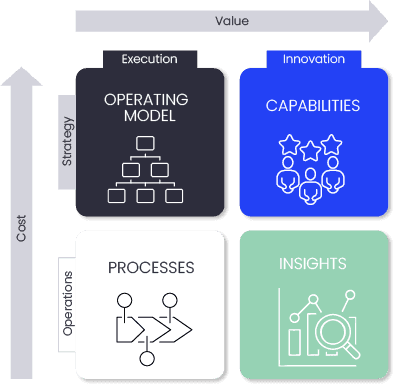


Cost-Value Matrix
To predict the success your strategy, you need to create a profound understanding of your operating model, capabilities, processes, and insights.
Discover opportunities to optimize & automate
Covers all aspects of an organization
Ready for Business Transformation


Cost-Value Matrix
To predict the success your strategy, you need to create a profound understanding of your operating model, capabilities, processes, and insights.
Discover opportunities to optimize & automate
Covers all aspects of an organization
Ready for Business Transformation

Context: Modern Digital Transformation
Context: Modern Digital Transformation
Context: Modern Digital Transformation
The need to maximize value, minimize cost and increase transparency is crucial in every organization and context. The overarching goals of modern digital transformation are to:
Change the Ways of Working to adopt a mindset of identifying and proposing continuous improvements across all functions.
Significantly increase initiatives with high-value and long return horizons.
Develop a digital mindset that welcomes new technologies and actively shapes innovation by being early adopters in core areas.
The need to maximize value, minimize cost and increase transparency is crucial in every organization and context. The overarching goals of modern digital transformation are to:
Change the Ways of Working to adopt a mindset of identifying and proposing continuous improvements across all functions.
Significantly increase initiatives with high-value and long return horizons.
Develop a digital mindset that welcomes new technologies and actively shapes innovation by being early adopters in core areas.
The need to maximize value, minimize cost and increase transparency is crucial in every organization and context. The overarching goals of modern digital transformation are to:
Change the Ways of Working to adopt a mindset of identifying and proposing continuous improvements across all functions.
Significantly increase initiatives with high-value and long return horizons.
Develop a digital mindset that welcomes new technologies and actively shapes innovation by being early adopters in core areas.
Changing the ways of working means changing the mindset around technology. It is to enable each individual in the organization to voice their issues, concern, and point out inefficiencies and risks in a rewarding way. Developing and retaining digital talent increases the likelihood of optimization, automation, and innovation. The whole organization needs to take part in this journey, as they step through the following stages:
Changing the ways of working means changing the mindset around technology. It is to enable each individual in the organization to voice their issues, concern, and point out inefficiencies and risks in a rewarding way. Developing and retaining digital talent increases the likelihood of optimization, automation, and innovation. The whole organization needs to take part in this journey, as they step through the following stages:
Changing the ways of working means changing the mindset around technology. It is to enable each individual in the organization to voice their issues, concern, and point out inefficiencies and risks in a rewarding way. Developing and retaining digital talent increases the likelihood of optimization, automation, and innovation. The whole organization needs to take part in this journey, as they step through the following stages:






Quick Wins
Quick Wins
Optimization, Automation
Identifying and executing quick wins to automate specific tasks or processes with low-code, RPA, and simple AI.
Identifying and executing quick wins to automate specific tasks or processes with low-code, RPA, and simple AI.
Examples of low-code solutions:
Lifting Excel Solutions into the Power Platform to create structured data sources for 360* reports. Comprehensive Power BI reports from multiple data sources. Process Mining to examine cycle, lead and lag times, identify inefficiencies and bundle into a Tender or preparation for bidding. Adding functionality to the CRM, ERP, PPM, DMS, or other, larger applications.
Examples of low-code solutions:
Lifting Excel Solutions into the Power Platform to create structured data sources for 360* reports. Comprehensive Power BI reports from multiple data sources. Process Mining to examine cycle, lead and lag times, identify inefficiencies and bundle into a Tender or preparation for bidding. Adding functionality to the CRM, ERP, PPM, DMS, or other, larger applications.



Business Applications
Business Applications
AI, Insights
Refreshing business applications for the core business as well as supporting functions, like Sales, Field Service, Project Operations, Customer Service, Marketing, and others.
Refreshing business applications for the core business as well as supporting functions, like Sales, Field Service, Project Operations, Customer Service, Marketing, and others.
Examples of business application implementations:
Project Operations, Field Services, Sales / CRM, Business Central ERP, SAP to Azure Data Lake, Learning Management System (LMS), Form Processing Solutions, Chat Bot Solutions, Data Mining.
Examples of business application implementations:
Project Operations, Field Services, Sales / CRM, Business Central ERP, SAP to Azure Data Lake, Learning Management System (LMS), Form Processing Solutions, Chat Bot Solutions, Data Mining.



ERP & Integration
ERP & Integration
Returns / Capital
Transforming the organization to optimize for budget discipline and transparency, increasing financial accountability for projects and programs.
Transforming the organization to optimize for budget discipline and transparency, increasing financial accountability for projects and programs.
How does the ERP increase value?
The ERP is the technological heart that scales with the organization. Because it holds all types of confidential monetary data, providing data to flow out and into the ERP introduces inefficiencies. Also, each value-generating product line or service starts having "exceptions" and other quirks.
By increasing the efficiency of the data model, the ERP can be a work horse for analytics and strategic decision-making.
How does the ERP increase value?
The ERP is the technological heart that scales with the organization. Because it holds all types of confidential monetary data, providing data to flow out and into the ERP introduces inefficiencies. Also, each value-generating product line or service starts having "exceptions" and other quirks.
By increasing the efficiency of the data model, the ERP can be a work horse for analytics and strategic decision-making.



Digital Mindset
Digital Mindset
Max. Capabilities
Empowering talented individuals to increase emotional intelligence, vision in innovation, business acumen, and accuracy, ethics & technical excellence.
Empowering talented individuals to increase emotional intelligence, vision in innovation, business acumen, and accuracy, ethics & technical excellence.
What are programs that promote a digital mindset?
Application Rationalization, Business Transformation, Digital Transformation, Work Elimination, Intranet Refresh.
What are programs that promote a digital mindset?
Application Rationalization, Business Transformation, Digital Transformation, Work Elimination, Intranet Refresh.
All of the above contribute to a modern business transformation, because of their direct impact on the end user. Accompanying, the following programs have recurring needs: hardware refresh / infrastructure modernization, application rationalization, master data management, procurement & vendor management, cybersecurity.
The cost-value matrix assists in identifying elements to modernize by evaluation their cost vs value.
All of the above contribute to a modern business transformation, because of their direct impact on the end user. Accompanying, the following programs have recurring needs: hardware refresh / infrastructure modernization, application rationalization, master data management, procurement & vendor management, cybersecurity.
The cost-value matrix assists in identifying elements to modernize by evaluation their cost vs value.
All of the above contribute to a modern business transformation, because of their direct impact on the end user. Accompanying, the following programs have recurring needs: hardware refresh / infrastructure modernization, application rationalization, master data management, procurement & vendor management, cybersecurity.
The cost-value matrix assists in identifying elements to modernize by evaluation their cost vs value.
Cost-Value Matrix
Cost-Value Matrix
Cost-Value Matrix



Cost can be broken down into expense and capital, afterwards following the account terminology of the organization.
Value is money created from strategic use of all capabilities.
Cost can be broken down into expense and capital, afterwards following the account terminology of the organization.
Value is money created from strategic use of all capabilities.
Cost can be broken down into expense and capital, afterwards following the account terminology of the organization.
Value is money created from strategic use of all capabilities.



Operating Model
Operating Model
Cost: High --- Value: Low
The core set up of the organization. Mission, vision, current strategy. Roles and responsibilities should align with the strategy.
Why is the operating model value low?
Natural hierarchy is static. In a human family or collective the actors may change, but the chain of command does not. Contrary to this, the model of organizations evolves given market conditions, disruptions, and internal factors. Therefore, executing changes to the operating model is costly because the everyone in the chain of command needs to respect these changes as a collective, while the value of those changes to the hierarchy is minimal or intangible.



Capabilities
Capabilities
Cost: High --- Value: High
Expertise within the organization. It aggregates skills, intellectual property, and the potential for innovation.
Why is the capabilities cost high?
Because human resources are the highest cost factor, the cost increases with the size of the operating model. This also means that the capabilities increase, and that strategies can be more refined and more initiatives can be executed.
On the other hand, tasks, processes, and procedures that rely on minimal decisive intelligence should be automated, outsourced, or eliminated.



Processes
Processes
Cost: Low --- Value: Low
The execution of operations and strategy. Operational and strategic process groups should be optimized and automated.
Why is the process value low?
Processes and procedures are overhead due to the lack of trust in the individuals ability to execute to quality. The more individuals take part in any given process, the longer it takes to get the given output. Highly skilled resources are restricted by process (i.e. R&D) while standardized processes enforce the same quality of output. If all resources were highly skilled, fit for the tasks given as well as living intrinsic work ethics and values, processes would be superfluous.



Insights
Insights
Cost: Low --- Value: High
Integrates information for all roles in the organization. Generated reports should depict the current state as close as possible.
Why is the insights value high?
Processes and procedures are overhead due to the lack of trust in the individuals ability to execute to quality. The more individuals take part in any given process, the longer it takes to get the given output. Highly skilled resources are restricted by process (i.e. R&D) while standardized processes enforce the same quality of output. If all resources were highly skilled, fit for the task and having intrinsic work ethics and values, processes would be superfluous.
Cost-Value Flows
Cost-Value Flows



Strategy Flow
Strategy Flow
Successfully executed strategies excel at defining measurable outcomes that create the highest value and measuring their progress near real-time through insights. Those highest value tasks are using up the most valuable capabilities and, through incentives and motivation, those capabilities are redefining themselves to further innovate.
Successfully executed strategies excel at defining measurable outcomes that create the highest value and measuring their progress near real-time through insights. Those highest value tasks are using up the most valuable capabilities and, through incentives and motivation, those capabilities are redefining themselves to further innovate.
Successfully executed strategies excel at defining measurable outcomes that create the highest value and measuring their progress near real-time through insights. Those highest value tasks are using up the most valuable capabilities and, through incentives and motivation, those capabilities are redefining themselves to further innovate.



Operations Flow
Operations Flow
Successfully executed operations rely on mature process systems that distinguish between agile and traditional modes; have multiple fail-safes for business continuity; and are monitored and governed to continuously improve based on process mining and other insights.
Successfully executed operations rely on mature process systems that distinguish between agile and traditional modes; have multiple fail-safes for business continuity; and are monitored and governed to continuously improve based on process mining and other insights.
Successfully executed operations rely on mature process systems that distinguish between agile and traditional modes; have multiple fail-safes for business continuity; and are monitored and governed to continuously improve based on process mining and other insights.



Execution Flow
Execution Flow
Both, the operating model and processes are low in value. Processes execute based on the roles & responsibilities, which should follow financial structures of the assets as well as the services and products. Successful organizations minimize the time to execute processes by optimizing how changes in the operating model flow through and affect process cost and output.
Both, the operating model and processes are low in value. Processes execute based on the roles & responsibilities, which should follow financial structures of the assets as well as the services and products. Successful organizations minimize the time to execute processes by optimizing how changes in the operating model flow through and affect process cost and output.
Both, the operating model and processes are low in value. Processes execute based on the roles & responsibilities, which should follow financial structures of the assets as well as the services and products. Successful organizations minimize the time to execute processes by optimizing how changes in the operating model flow through and affect process cost and output.



Innovation Flow
Innovation Flow
While human resources are the highest cost factor, they are also the sole source of innovation (at least until AI will be able to innovate itself). Engaging with the most talented resources and allowing them to have motivating roles with elevated responsibilities will yield the highest value, especially when those resources are retained in the organization over a longer period of time.
While human resources are the highest cost factor, they are also the sole source of innovation (at least until AI will be able to innovate itself). Engaging with the most talented resources and allowing them to have motivating roles with elevated responsibilities will yield the highest value, especially when those resources are retained in the organization over a longer period of time.
While human resources are the highest cost factor, they are also the sole source of innovation (at least until AI will be able to innovate itself). Engaging with the most talented resources and allowing them to have motivating roles with elevated responsibilities will yield the highest value, especially when those resources are retained in the organization over a longer period of time.
Discovering opportunities to automate, optimize, and innovate requires identifying high-value tasks and removing capabilities from non-value added tasks. Assessing the value and cost of any task requires defining the elements that aggregate up to the sums of cost and the sums of value. This is comprised of the process. available insights, capabilities, and the context of that task within the operating model.
Cost = Processing time in hours * (blended rate of role in operating model - blended rate of skill at fair market rate) * communication channels (n * (n-1) / 2)
Value = Variability of process outcomes * impact on return in value chain + potential process / task chaining
Because this applies to all organizational processes, be it revenue-generating, sustaining, or strategically-focused, the Cost-Value Method can be applied and tracked for any type of organization (company, business unit, division, department).
The goal is to reveal and take action on quick wins that are high in value, as well as longer-termed transformation efforts for innovation.
Discovering opportunities to automate, optimize, and innovate requires identifying high-value tasks and removing capabilities from non-value added tasks. Assessing the value and cost of any task requires defining the elements that aggregate up to the sums of cost and the sums of value. This is comprised of the process. available insights, capabilities, and the context of that task within the operating model.
Cost = Processing time in hours * (blended rate of role in operating model - blended rate of skill at fair market rate) * communication channels (n * (n-1) / 2)
Value = Variability of process outcomes * impact on return in value chain + potential process / task chaining
Because this applies to all organizational processes, be it revenue-generating, sustaining, or strategically-focused, the Cost-Value Method can be applied and tracked for any type of organization (company, business unit, division, department).
The goal is to reveal and take action on quick wins that are high in value, as well as longer-termed transformation efforts for innovation.
Discovering opportunities to automate, optimize, and innovate requires identifying high-value tasks and removing capabilities from non-value added tasks. Assessing the value and cost of any task requires defining the elements that aggregate up to the sums of cost and the sums of value. This is comprised of the process. available insights, capabilities, and the context of that task within the operating model.
Cost = Processing time in hours * (blended rate of role in operating model - blended rate of skill at fair market rate) * communication channels (n * (n-1) / 2)
Value = Variability of process outcomes * impact on return in value chain + potential process / task chaining
Because this applies to all organizational processes, be it revenue-generating, sustaining, or strategically-focused, the Cost-Value Method can be applied and tracked for any type of organization (company, business unit, division, department).
The goal is to reveal and take action on quick wins that are high in value, as well as longer-termed transformation efforts for innovation.
Strategy and Operation Alignment Examples
Strategy and Operation Alignment Examples



Safety Strategy
Safety Strategy
How well the organization performs on the Strategy depends on how well all organizational capabilities align with the structure of the operating model. For example, energy companies strive for operational excellence. Their strategies often emphasize safety as a measurable, strategic goal. Therefore, capabilities should be centered around delivering effective and efficient methods to train all employees on safety hazards. Additionally, within the operating model there should be appropriate roles and responsibilities given to resources that work in the safety field (up to the board level). If then everyone consistently and continuously receives safety training modules and a culture of "safety" is cultivated the strategic goal of "close to zero incidents" should be achievable, because the capabilities are aligned with the strategic goal.
How well the organization performs on the Strategy depends on how well all organizational capabilities align with the structure of the operating model. For example, energy companies strive for operational excellence. Their strategies often emphasize safety as a measurable, strategic goal. Therefore, capabilities should be centered around delivering effective and efficient methods to train all employees on safety hazards. Additionally, within the operating model there should be appropriate roles and responsibilities given to resources that work in the safety field (up to the board level). If then everyone consistently and continuously receives safety training modules and a culture of "safety" is cultivated the strategic goal of "close to zero incidents" should be achievable, because the capabilities are aligned with the strategic goal.



Order-to-Cash Operations
Order-to-Cash Operations
How well the organization performs in Operations depends on the measurement of processes (including cross-functional, integrated processes) given transparency, efficiency, timeliness of data and dashboards for all stakeholders. For example, executing work orders from warehouses requires a complex system of processes and procedures. Especially, tracking materials and product can be overly complex in account when multiple companies are involved. Therefore, the data that flows through the order-to-cash process is highly critical for cash flow calculations. Front-line workers, operations managers, procurement, accountants, and upper management have different demands to view the data to take proper action within their specific role. Operations can only be as efficient as the insights provided to all stakeholders to continuously improve the processes. Short: insights drive processes to operational excellence.
How well the organization performs in Operations depends on the measurement of processes (including cross-functional, integrated processes) given transparency, efficiency, timeliness of data and dashboards for all stakeholders. For example, executing work orders from warehouses requires a complex system of processes and procedures. Especially, tracking materials and product can be overly complex in account when multiple companies are involved. Therefore, the data that flows through the order-to-cash process is highly critical for cash flow calculations. Front-line workers, operations managers, procurement, accountants, and upper management have different demands to view the data to take proper action within their specific role. Operations can only be as efficient as the insights provided to all stakeholders to continuously improve the processes. Short: insights drive processes to operational excellence.
Operating Model
Operating Model
Operating Model
The operating model is comprised of the Vision, Mission, Organizational Chart in conjunction with Roles & Responsibilities, and Strategic Drivers with their current Targets. It legitimates the chain of command through which the vision and strategy should be achieved.
The operating model is comprised of the Vision, Mission, Organizational Chart in conjunction with Roles & Responsibilities, and Strategic Drivers with their current Targets. It legitimates the chain of command through which the vision and strategy should be achieved.
The operating model is comprised of the Vision, Mission, Organizational Chart in conjunction with Roles & Responsibilities, and Strategic Drivers with their current Targets. It legitimates the chain of command through which the vision and strategy should be achieved.
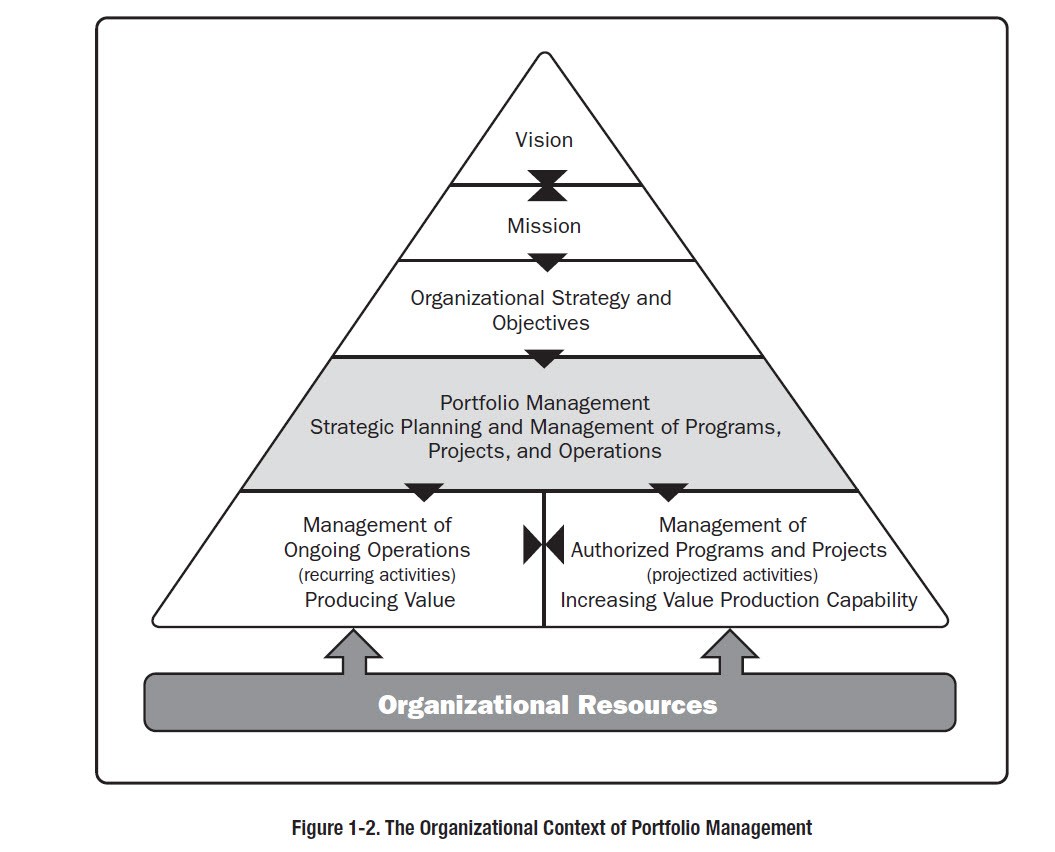


Business Transformation aims to balance resource demands to execute strategy while maintaining value-generating operations. This is a difficult undertaking, as organizational resources should be scarce in lean organizations. If there is an abundance of resources the suspicion of inefficiency has to be investigated. At the same time, reasonable backup capabilities (aka bench) should be available at all times. Inefficiencies can be introduced by capabilities leaving without proper (or even more skilled) replacement.
Identifying the most valuable resources and empowering them to hone in on their creativity, intelligence, and strong work ethics is the primary goal of the cost-value method.
Chain of Command
The constellation, incentives in compensation of the board of directors and external condition will strongly influence how strategy is formulated. Strategic goals should be formulated so that, in the best case, there won't be overlap in the operating model in lower levels of the organization. This will require a thorough analysis of where
Roles & Responsibilities create friction between different levels of the organization (for example directors and managers across business units);
Processes and procedures have bottlenecks that require multiple touchpoints across or outside of the organization (see "Processes" section below);
Capabilities are "more than redundant", for example one specific skill is available in most resources, yet only needed sporadically.
The core of the operating model is the organizational chart with its roles & responsibilities. As of April 2024, for Apple it looks as follows:
Business Transformation aims to balance resource demands to execute strategy while maintaining value-generating operations. This is a difficult undertaking, as organizational resources should be scarce in lean organizations. If there is an abundance of resources the suspicion of inefficiency has to be investigated. At the same time, reasonable backup capabilities (aka bench) should be available at all times. Inefficiencies can be introduced by capabilities leaving without proper (or even more skilled) replacement.
Identifying the most valuable resources and empowering them to hone in on their creativity, intelligence, and strong work ethics is the primary goal of the cost-value method.
Chain of Command
The constellation, incentives in compensation of the board of directors and external condition will strongly influence how strategy is formulated. Strategic goals should be formulated so that, in the best case, there won't be overlap in the operating model in lower levels of the organization. This will require a thorough analysis of where
Roles & Responsibilities create friction between different levels of the organization (for example directors and managers across business units);
Processes and procedures have bottlenecks that require multiple touchpoints across or outside of the organization (see "Processes" section below);
Capabilities are "more than redundant", for example one specific skill is available in most resources, yet only needed sporadically.
The core of the operating model is the organizational chart with its roles & responsibilities. As of April 2024, for Apple it looks as follows:
Business Transformation aims to balance resource demands to execute strategy while maintaining value-generating operations. This is a difficult undertaking, as organizational resources should be scarce in lean organizations. If there is an abundance of resources the suspicion of inefficiency has to be investigated. At the same time, reasonable backup capabilities (aka bench) should be available at all times. Inefficiencies can be introduced by capabilities leaving without proper (or even more skilled) replacement.
Identifying the most valuable resources and empowering them to hone in on their creativity, intelligence, and strong work ethics is the primary goal of the cost-value method.
Chain of Command
The constellation, incentives in compensation of the board of directors and external condition will strongly influence how strategy is formulated. Strategic goals should be formulated so that, in the best case, there won't be overlap in the operating model in lower levels of the organization. This will require a thorough analysis of where
Roles & Responsibilities create friction between different levels of the organization (for example directors and managers across business units);
Processes and procedures have bottlenecks that require multiple touchpoints across or outside of the organization (see "Processes" section below);
Capabilities are "more than redundant", for example one specific skill is available in most resources, yet only needed sporadically.
The core of the operating model is the organizational chart with its roles & responsibilities. As of April 2024, for Apple it looks as follows:
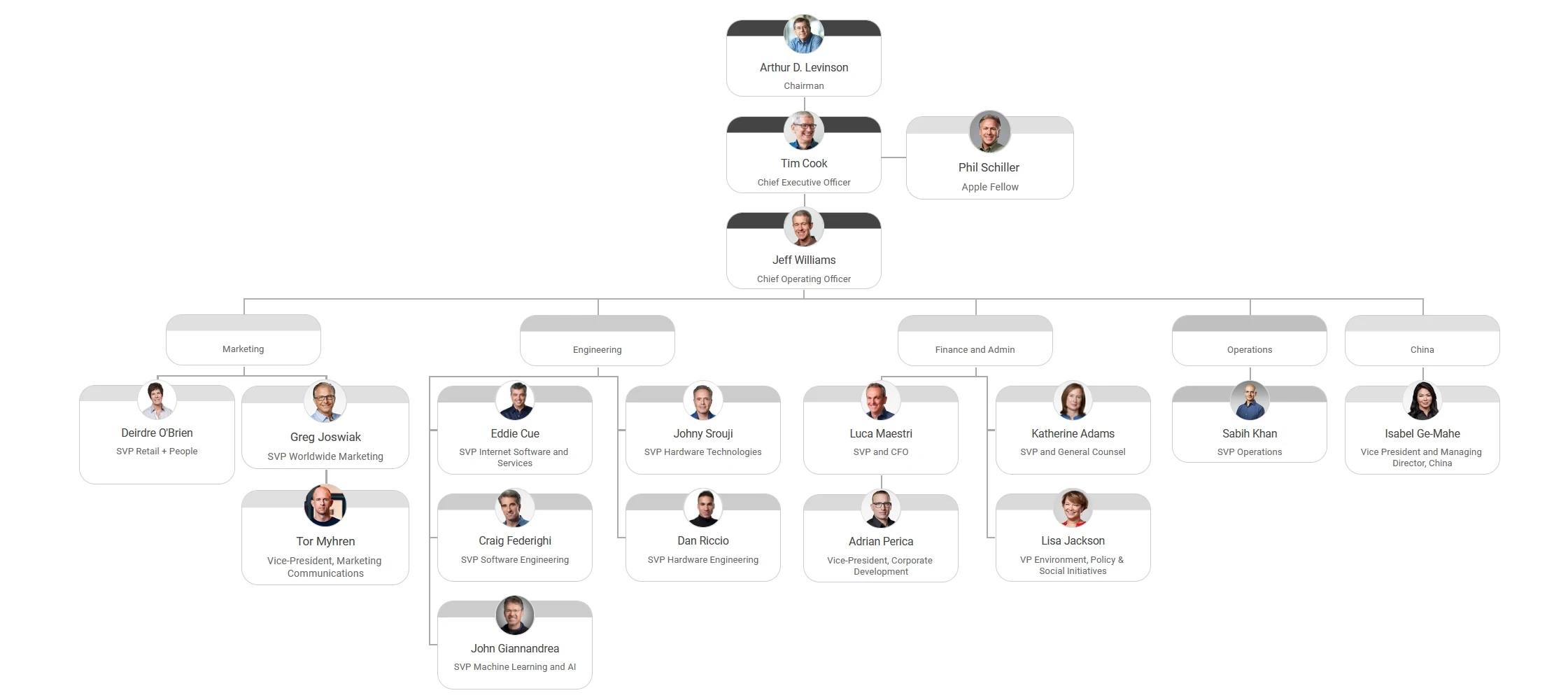


It highlights the emphasis on the strategy that the company is poised to execute. Apart from common business units (Marketing, Engineering, Finance, Operations), China is at the top level due to the importance of the Chinese market as well as manufacturing suppliers and logistics that bind Apple to the country.
Then, apart from executive compensation, the HR strategy holds detailed descriptions of roles and responsibilities to incentivize each layer of the organization to execute strategy at their best.
Business Driver Formulation
Strategy is set on different timeframes. Here, we focus on strategic drivers with current, annual targets. While the strategy might be well-known and easy to communicate, defining strategic drivers and targets per annum follows a predetermined syntax that is measurable by benchmarked KPIs that programs and projects can be compared to:
It highlights the emphasis on the strategy that the company is poised to execute. Apart from common business units (Marketing, Engineering, Finance, Operations), China is at the top level due to the importance of the Chinese market as well as manufacturing suppliers and logistics that bind Apple to the country.
Then, apart from executive compensation, the HR strategy holds detailed descriptions of roles and responsibilities to incentivize each layer of the organization to execute strategy at their best.
Business Driver Formulation
Strategy is set on different timeframes. Here, we focus on strategic drivers with current, annual targets. While the strategy might be well-known and easy to communicate, defining strategic drivers and targets per annum follows a predetermined syntax that is measurable by benchmarked KPIs that programs and projects can be compared to:
It highlights the emphasis on the strategy that the company is poised to execute. Apart from common business units (Marketing, Engineering, Finance, Operations), China is at the top level due to the importance of the Chinese market as well as manufacturing suppliers and logistics that bind Apple to the country.
Then, apart from executive compensation, the HR strategy holds detailed descriptions of roles and responsibilities to incentivize each layer of the organization to execute strategy at their best.
Business Driver Formulation
Strategy is set on different timeframes. Here, we focus on strategic drivers with current, annual targets. While the strategy might be well-known and easy to communicate, defining strategic drivers and targets per annum follows a predetermined syntax that is measurable by benchmarked KPIs that programs and projects can be compared to:



Capabilities
Capabilities
Capabilities
The sum of all skills and enablers that make up the operating model are the measured capabilities. Anything that is needed to execute the strategy are desired capabilities. Those might, or might not match what is measured. To measure capabilities an organization could have a skill matrix as follows:
The sum of all skills and enablers that make up the operating model are the measured capabilities. Anything that is needed to execute the strategy are desired capabilities. Those might, or might not match what is measured. To measure capabilities an organization could have a skill matrix as follows:
The sum of all skills and enablers that make up the operating model are the measured capabilities. Anything that is needed to execute the strategy are desired capabilities. Those might, or might not match what is measured. To measure capabilities an organization could have a skill matrix as follows:



In this example the heat map easily visualizes skill gaps for individuals. The sum of the values per color will reveal the measured capabilities. To narrow the capabilities down to the available capabilities to execute projects or programs to fulfill the strategic targets we would need to deduct the availability per individual from their measured capabilities.
To resolve the gap between the measured capabilities and available capabilities the organization can:
In this example the heat map easily visualizes skill gaps for individuals. The sum of the values per color will reveal the measured capabilities. To narrow the capabilities down to the available capabilities to execute projects or programs to fulfill the strategic targets we would need to deduct the availability per individual from their measured capabilities.
To resolve the gap between the measured capabilities and available capabilities the organization can:
In this example the heat map easily visualizes skill gaps for individuals. The sum of the values per color will reveal the measured capabilities. To narrow the capabilities down to the available capabilities to execute projects or programs to fulfill the strategic targets we would need to deduct the availability per individual from their measured capabilities.
To resolve the gap between the measured capabilities and available capabilities the organization can:



Increase the number of resources (and thus cost)
Increase the number of resources (and thus cost)



Allow more cost inside the operating model and procure outside capabilities
Allow more cost inside the operating model and procure outside capabilities



Rethink strategic driver definition and scope
Rethink strategic driver definition and scope



Lower strategic targets / KPIs
Lower strategic targets / KPIs



Prioritize optimization efforts in the specific area to close the gap
Prioritize optimization efforts in the specific area to close the gap
Capabilities exist to deliver products and services. Eventually, to also fulfill strategic goals the capabilities need to be aligned with the desired portfolio of products and services. Thus:
Desired capabilities = Capabilities to reach desired portfolio performance - Available capabilities
To find a desired capabilities model, the products and services within a portfolio have to be categorized by current performance and potential value. While the classic BCG Matrix focuses only on exploiting existing portfolios, the following approach from Alexander Osterwalder (Business Model Canvas, strategyzer.com) extends this lifecycle (BM = Business Model, here: product or service):
Capabilities exist to deliver products and services. Eventually, to also fulfill strategic goals the capabilities need to be aligned with the desired portfolio of products and services. Thus:
Desired capabilities = Capabilities to reach desired portfolio performance - Available capabilities
To find a desired capabilities model, the products and services within a portfolio have to be categorized by current performance and potential value. While the classic BCG Matrix focuses only on exploiting existing portfolios, the following approach from Alexander Osterwalder (Business Model Canvas, strategyzer.com) extends this lifecycle (BM = Business Model, here: product or service):
Capabilities exist to deliver products and services. Eventually, to also fulfill strategic goals the capabilities need to be aligned with the desired portfolio of products and services. Thus:
Desired capabilities = Capabilities to reach desired portfolio performance - Available capabilities
To find a desired capabilities model, the products and services within a portfolio have to be categorized by current performance and potential value. While the classic BCG Matrix focuses only on exploiting existing portfolios, the following approach from Alexander Osterwalder (Business Model Canvas, strategyzer.com) extends this lifecycle (BM = Business Model, here: product or service):
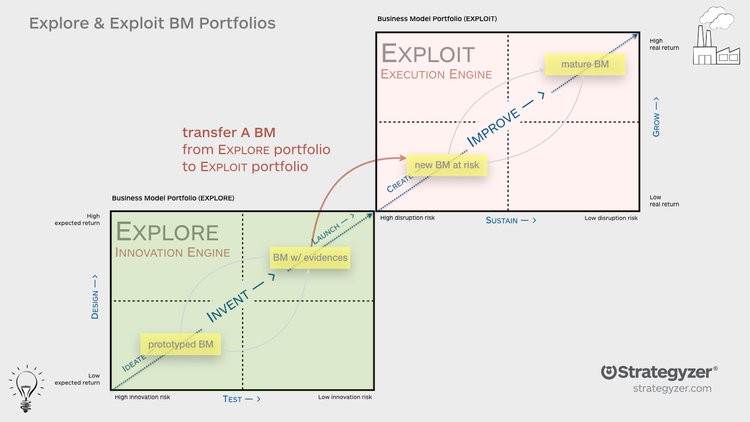


The "Explore" part of the portfolio enables a prototype/test early culture. This approach crystallizes gaps in capabilities to execute the desired programs and projects. To extend the capabilities, organizations can:



Pull internal resources into the projects
Pull internal resources into the projects



Upskill internal resources
Upskill internal resources



Use contingent labor
Use contingent labor



Contract with a vendor, supplier, or any other company per Statement of Work (SoW)
Contract with a vendor, supplier, or any other company per Statement of Work (SoW)



Use a Managed Service Provider (MSP)
Use a Managed Service Provider (MSP)
The choice will depend on company culture and budgetary constraints.
Other capabilities are any assets that help deliver the strategy, including intellectual property and physical assets (as defined by accounting).
The cost-value matrix states that:
The predicted success of strategy is the sum of the desired capabilities.
The choice will depend on company culture and budgetary constraints.
Other capabilities are any assets that help deliver the strategy, including intellectual property and physical assets (as defined by accounting).
The cost-value matrix states that:
The predicted success of strategy is the sum of the desired capabilities.
Processes
Processes
Processes
The organization executes the strategy through processes. Lack of optimization and automation leads to slow executing processes or process gaps. Those gaps need to be filled through manual labor and increase cost for the organization. While every organization will have different business process maps, process systems, and processes, a simplified assessments can evaluate dimensions of the organization according to Leavitt's Diamond Model (1965) as follows:
The organization executes the strategy through processes. Lack of optimization and automation leads to slow executing processes or process gaps. Those gaps need to be filled through manual labor and increase cost for the organization. While every organization will have different business process maps, process systems, and processes, a simplified assessments can evaluate dimensions of the organization according to Leavitt's Diamond Model (1965) as follows:
The organization executes the strategy through processes. Lack of optimization and automation leads to slow executing processes or process gaps. Those gaps need to be filled through manual labor and increase cost for the organization. While every organization will have different business process maps, process systems, and processes, a simplified assessments can evaluate dimensions of the organization according to Leavitt's Diamond Model (1965) as follows:
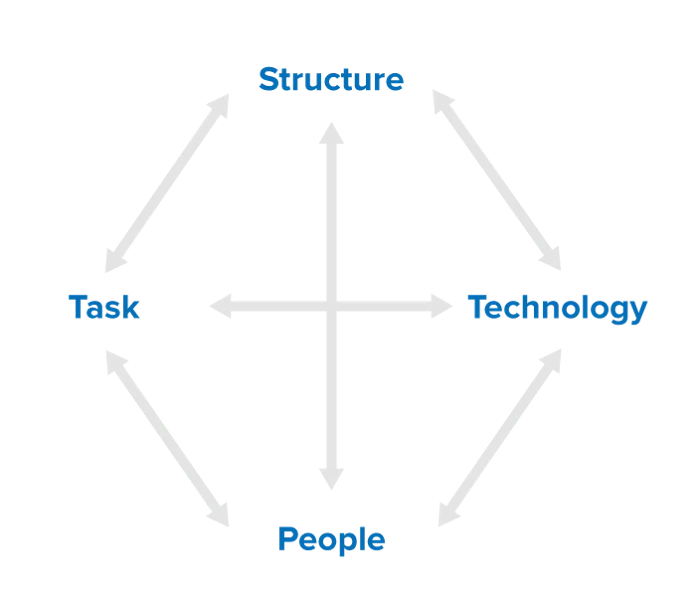


The structure can be derived from the operating model and the people hold the capabilities. Tasks and technology are defined as lower levels of strategy that eventually have an output, preferably measurable and tied back to strategic targets. This, of course, doesn't work for all processes. Some are operational to sustain the current state with no logically measurable value, like office admin work. With increasing automation those common processes will require less manual work. To discover processes that can be rationalized, automated, outsourced, or integrated with each other, the process map of the organization should be analyzed accordingly.
In product-centric organizations processes map to activities in Porter's Value Chain as follows:
The structure can be derived from the operating model and the people hold the capabilities. Tasks and technology are defined as lower levels of strategy that eventually have an output, preferably measurable and tied back to strategic targets. This, of course, doesn't work for all processes. Some are operational to sustain the current state with no logically measurable value, like office admin work. With increasing automation those common processes will require less manual work. To discover processes that can be rationalized, automated, outsourced, or integrated with each other, the process map of the organization should be analyzed accordingly.
In product-centric organizations processes map to activities in Porter's Value Chain as follows:
The structure can be derived from the operating model and the people hold the capabilities. Tasks and technology are defined as lower levels of strategy that eventually have an output, preferably measurable and tied back to strategic targets. This, of course, doesn't work for all processes. Some are operational to sustain the current state with no logically measurable value, like office admin work. With increasing automation those common processes will require less manual work. To discover processes that can be rationalized, automated, outsourced, or integrated with each other, the process map of the organization should be analyzed accordingly.
In product-centric organizations processes map to activities in Porter's Value Chain as follows:
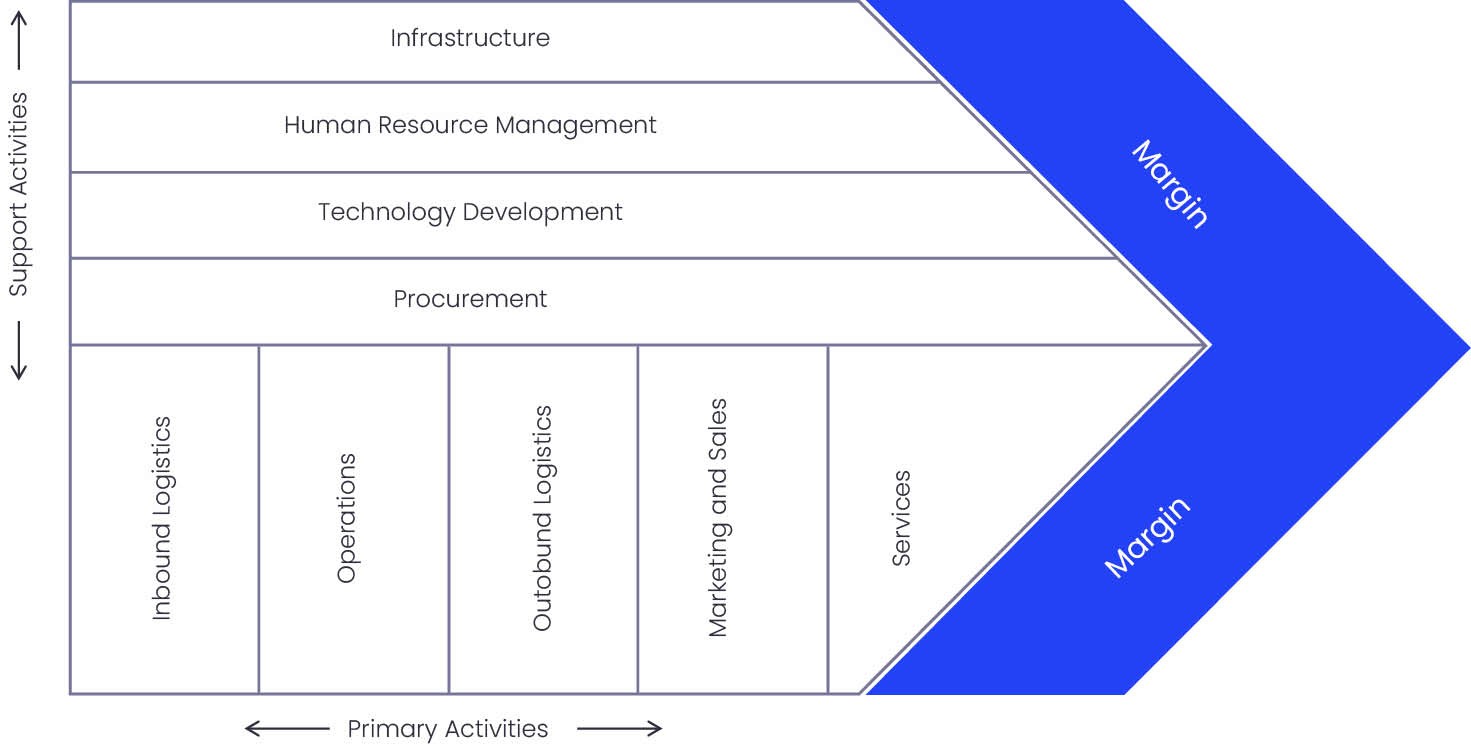


Product-centric organization focus on optimizing primary activities, because they rely heavily on logistics and their supply chain, where parts of the processes are often outside of their control. Yet, supporting activities provide excellent opportunities for automation and optimization. Due to lower criticality, those changes can make a large impact without disrupting operations.
For processes to be efficient, the cycle time should be minimized while keeping the quality high. This is especially tricky when any of the above activities are performed outside of the organization, for example in partnership with the HR department, Procurement, etc. or outsourced to partners or child companies altogether.
Product-centric organization focus on optimizing primary activities, because they rely heavily on logistics and their supply chain, where parts of the processes are often outside of their control. Yet, supporting activities provide excellent opportunities for automation and optimization. Due to lower criticality, those changes can make a large impact without disrupting operations.
For processes to be efficient, the cycle time should be minimized while keeping the quality high. This is especially tricky when any of the above activities are performed outside of the organization, for example in partnership with the HR department, Procurement, etc. or outsourced to partners or child companies altogether.
Product-centric organization focus on optimizing primary activities, because they rely heavily on logistics and their supply chain, where parts of the processes are often outside of their control. Yet, supporting activities provide excellent opportunities for automation and optimization. Due to lower criticality, those changes can make a large impact without disrupting operations.
For processes to be efficient, the cycle time should be minimized while keeping the quality high. This is especially tricky when any of the above activities are performed outside of the organization, for example in partnership with the HR department, Procurement, etc. or outsourced to partners or child companies altogether.
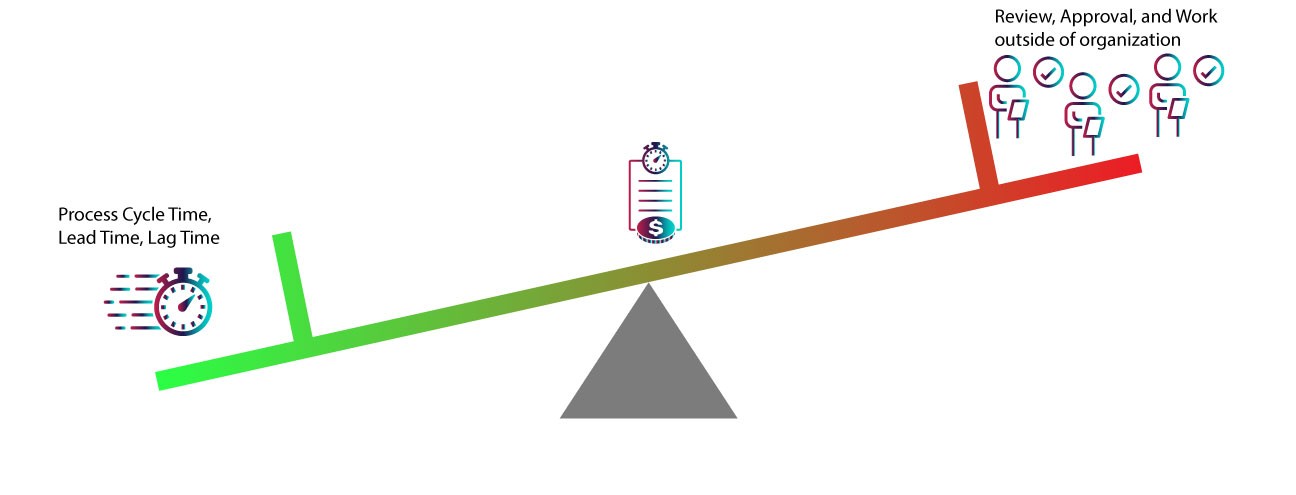


Even when automated, approvals and work outside of the organization tend to create bottlenecks and strong leadership backing is needed to resolve this by prioritizing the work of a given process that needs to be sped up.
In service-centric organizations a more appropriate model to capture process groups holistically is the Business Model Canvas:
Even when automated, approvals and work outside of the organization tend to create bottlenecks and strong leadership backing is needed to resolve this by prioritizing the work of a given process that needs to be sped up.
In service-centric organizations a more appropriate model to capture process groups holistically is the Business Model Canvas:
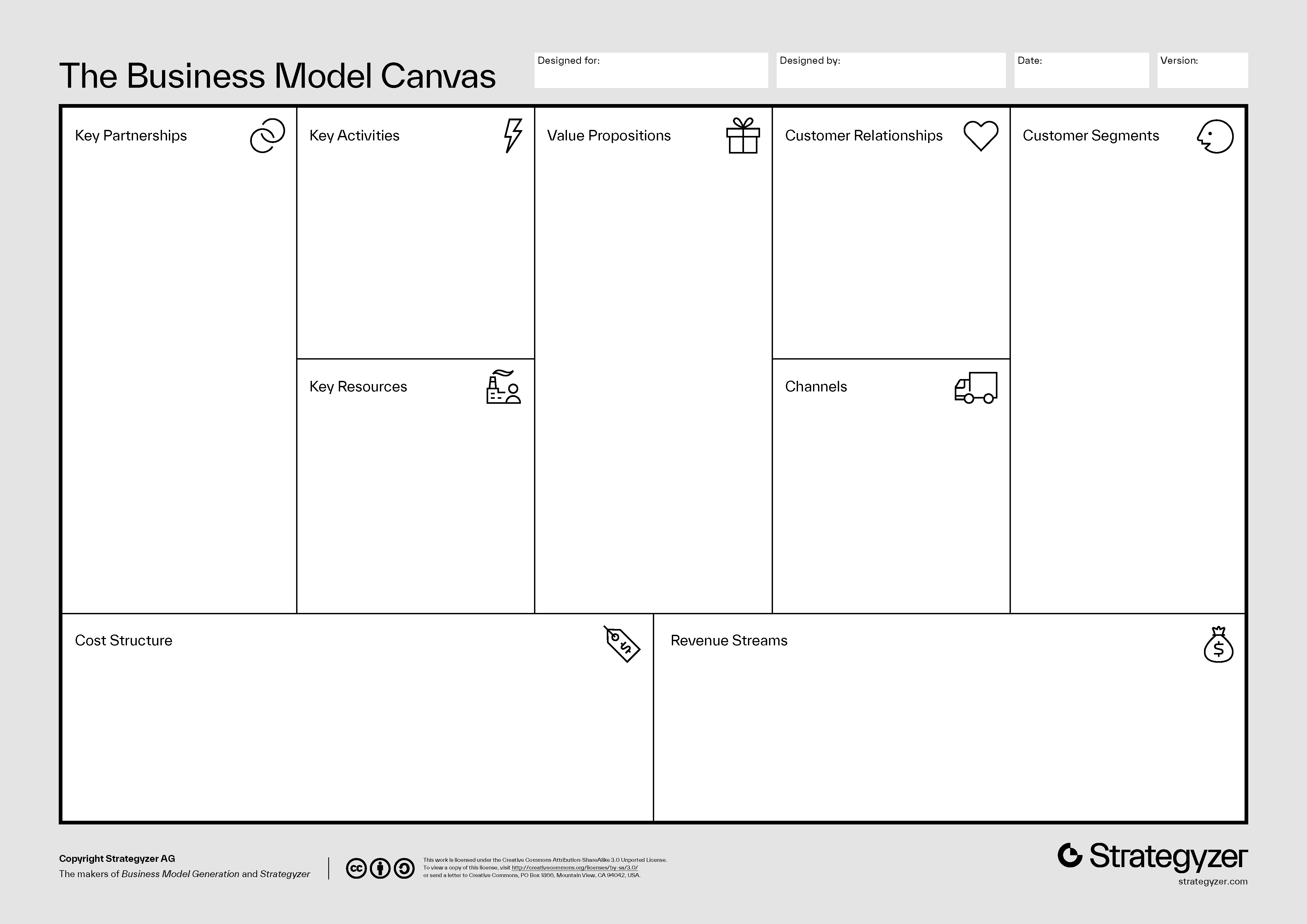


Each element in the Business Model Canvas can be viewed as structured, data-based interactions. For example, Cost Structure and Revenue Streams are following Accounting processes; Key Activities are generating the Process Outcomes; Key Resources need to be managed (onboarded, offboarded, incentivized, controlled); and Customer Relations, Channels, and Customer Segments are equal to Marketing and Sales processes.
Service-centric organizations are quicker to adjust each element and thus, have to be more careful to avoid reducing the quality of service when modifying processes.
To complete the picture of processes, each process requires tools and often templates to work with, be it either in a manufacturing plant, hospital, branch of a bank, or back office at Headquarters. Getting a complete picture of a process through the SIPOC method can reveal
Outdated assumptions;
Use of unnecessary tools
Overengineering; or
Lack of integration with other, newer processes in the same process group.
See a sample SIPOC process for invoicing below:
Each element in the Business Model Canvas can be viewed as structured, data-based interactions. For example, Cost Structure and Revenue Streams are following Accounting processes; Key Activities are generating the Process Outcomes; Key Resources need to be managed (onboarded, offboarded, incentivized, controlled); and Customer Relations, Channels, and Customer Segments are equal to Marketing and Sales processes.
Service-centric organizations are quicker to adjust each element and thus, have to be more careful to avoid reducing the quality of service when modifying processes.
To complete the picture of processes, each process requires tools and often templates to work with, be it either in a manufacturing plant, hospital, branch of a bank, or back office at Headquarters. Getting a complete picture of a process through the SIPOC method can reveal
Outdated assumptions;
Use of unnecessary tools
Overengineering; or
Lack of integration with other, newer processes in the same process group.
See a sample SIPOC process for invoicing below:
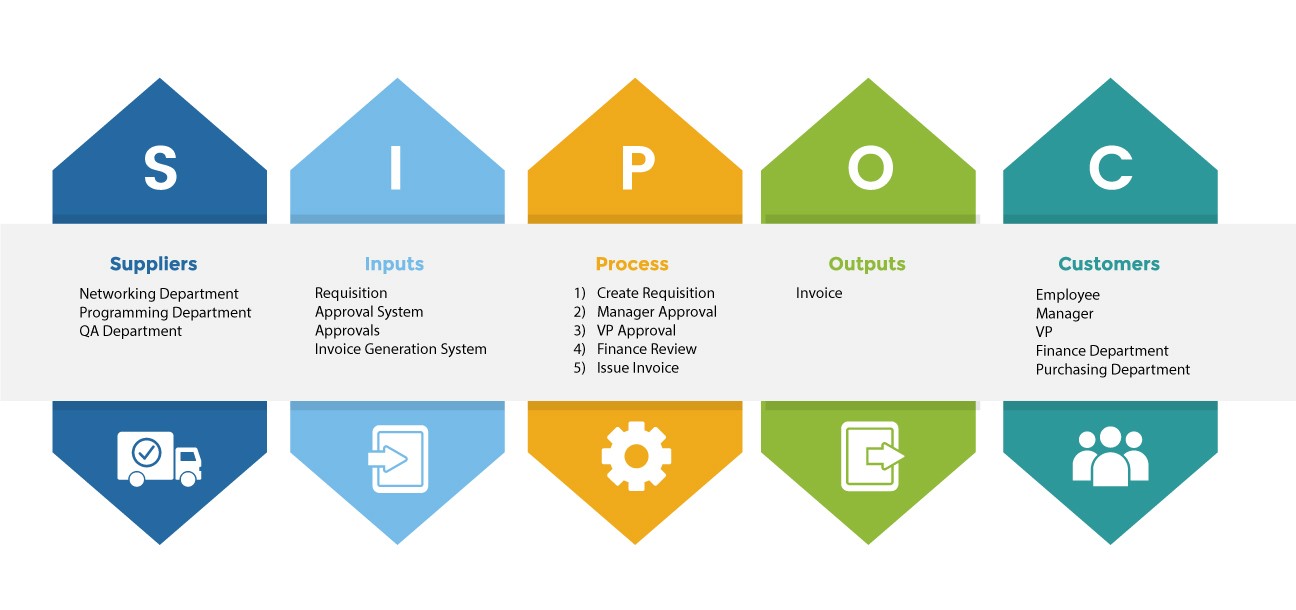


When processes are contained within the organization, it is unnecessary to list Suppliers and Customers as they will be the same. For those processes, one can only define Inputs, Process, and Outputs.
The cost-value matrix states that:
The executed success of strategy is the sum of value of all processes.
When processes are contained within the organization, it is unnecessary to list Suppliers and Customers as they will be the same. For those processes, one can only define Inputs, Process, and Outputs.
The cost-value matrix states that:
The executed success of strategy is the sum of value of all processes.
Insights
Insights
Insights
The quickest win to amend value to an organization is transparent reporting.
Organizational culture, security clearance requirements, and use of legacy systems can hinder advancing such reporting efforts. Furthermore, security structures can be difficult to model in BI tools and the use of AI is prohibitive on Personal Identifiable Information (PII), thus, making it more difficult to implement 360 reporting views.
To conquer these challenges, the organization can centralize the distribution of information by establishing a Community for Insights or an Analytics Center of Excellence.
For example, Microsoft published a blueprint for a Reporting Center of Excellence and provides guidance on how to establish one in any organization.
Further enhancing reporting with Machine Learning Models allows for AI to be introduced safely to the organization, given that processes and data are security trimmed and PII is handled appropriately. For example, contact information of sales lead should only be accessible by users and groups that would be allowed to contact them.
Investigating the data pipeline helps determine responsibilities and security for data across the organization. The following diagram shows the Microsoft Azure BI platform:
The quickest win to amend value to an organization is transparent reporting.
Organizational culture, security clearance requirements, and use of legacy systems can hinder advancing such reporting efforts. Furthermore, security structures can be difficult to model in BI tools and the use of AI is prohibitive on Personal Identifiable Information (PII), thus, making it more difficult to implement 360 reporting views.
To conquer these challenges, the organization can centralize the distribution of information by establishing a Community for Insights or an Analytics Center of Excellence.
For example, Microsoft published a blueprint for a Reporting Center of Excellence and provides guidance on how to establish one in any organization.
Further enhancing reporting with Machine Learning Models allows for AI to be introduced safely to the organization, given that processes and data are security trimmed and PII is handled appropriately. For example, contact information of sales lead should only be accessible by users and groups that would be allowed to contact them.
Investigating the data pipeline helps determine responsibilities and security for data across the organization. The following diagram shows the Microsoft Azure BI platform:
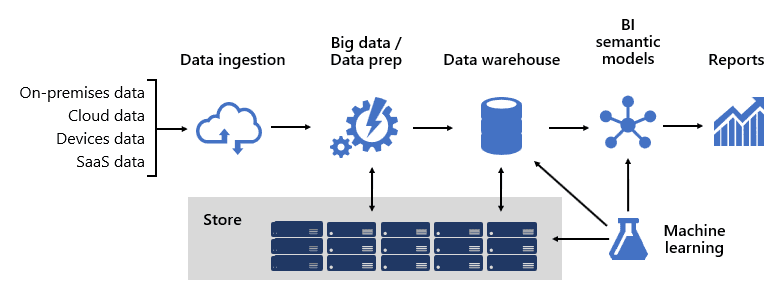


The data sources and security groups and considerations are paramount to build and continuously improve an Analytics Center of Excellence.
Th quality of outputs from Machine Learning Models is highly dependent on the quality of the data used. It is not uncommon to iterate multiple years over versions of the same model before deploying successfully to a broader, internal audience.
The low-hanging fruit is the creation of the reports. Given that a robust BI platform exists, procuring or training the capabilities to create those valuable insights should be accomplished in the short-term.
The cost-value matrix states that:
All levels of the operating model have access to the predicted and executed success of strategy.
The data sources and security groups and considerations are paramount to build and continuously improve an Analytics Center of Excellence.
Th quality of outputs from Machine Learning Models is highly dependent on the quality of the data used. It is not uncommon to iterate multiple years over versions of the same model before deploying successfully to a broader, internal audience.
The low-hanging fruit is the creation of the reports. Given that a robust BI platform exists, procuring or training the capabilities to create those valuable insights should be accomplished in the short-term.
The cost-value matrix states that:
All levels of the operating model have access to the predicted and executed success of strategy.
Conclusion
Conclusion
Conclusion
Assessing the operating model, capabilities, processes, and reporting brings organizations closer to realize the vision. The objective is to reveal opportunities to automate, optimize, and innovate. The result should be a list of prioritized gaps that need to be closed to get closer to the vision with value propositions for each initiative.
If any metric can not be tracked across each element, we assume a disconnect between strategy and execution.
Eventually, the cost-value matrix is a tool that allows anyone in the organization to discover opportunities for improvement and innovation. The most efficient application of the cost-value matrix will start as a top-down approach to guarantee the most complete information on the four elements.
Assessing the operating model, capabilities, processes, and reporting brings organizations closer to realize the vision. The objective is to reveal opportunities to automate, optimize, and innovate. The result should be a list of prioritized gaps that need to be closed to get closer to the vision with value propositions for each initiative.
If any metric can not be tracked across each element, we assume a disconnect between strategy and execution.
Eventually, the cost-value matrix is a tool that allows anyone in the organization to discover opportunities for improvement and innovation. The most efficient application of the cost-value matrix will start as a top-down approach to guarantee the most complete information on the four elements.
References
1) Project Management Institute. The Standard for Portfolio Management. 3rd ed., Project Management Institute, 2013.
2) Korukonda, R. Korukula. Organizational Portfolio Management: A Practitioner’s Guide. J. Ross Publishing, 2013.
3) Osterwalder, Alexander, and Yves Pigneur. Business Model Generation: A Handbook for Visionaries, Game Changers, and Challengers. Wiley, 2010.
4) Osterwalder, Alexander, et al. The Invincible Company: How to Constantly Reinvent Your Organization with Inspiration from the World's Best Business Models. Wiley, 2020.
5) Leavitt, Harold J. "Applied Organizational Change in Industry: Structural, Technological, and Humanistic Approaches." New Perspectives in Organizational Research, edited by Warren G. Bennis, Kenneth D. Benne, and Robert Chin, Wiley, 1969, pp. 55-71.
6) Porter, Michael E. Competitive Advantage: Creating and Sustaining Superior Performance. Free Press, 1985.
7) "Center of Excellence - Business Intelligence Solution Architecture." Microsoft Learn, Microsoft. Accessed 2 July 2024., Weblink.